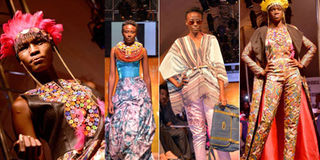Why fashion creatives matter more than ever

Models showcase creations by Kenyan designers during the 14th Session of the United Nations Conference on Trade and Development (UNCTAD14) at KICC in Nairobi on July 19, 2016. PHOTO | SALATON NJAU
What you need to know:
- Creatives have their own lingo while finance speaks profit margins and capital. Creatives wonder what money wants and money can’t figure out what creatives are selling. It’s a hot mess.
- It is similar to BagBorroworSteal, hiring designer bags for a day, week or month without having to spend an entire year’s savings on the latest IT bag.
- Fashion constantly unearths new markets. Menswear is explosive. The kiddie, maternity and plus size markets are expanding. Niche markets continue to emerge as consumers grow more vocal and demanding. Businesses constantly investigate ways to grow consumer loyalty.
Show Me The Money,” said HEVA Fund officials during a discussion about creative economies at the just concluded UNCTAD14. The panelists were drawn from creative industries such as arts, media, film, video games, music, publishing, design (fashion, interior, graphic), architecture and advertising. Ther mentioned familiar stuff I write about. Still, I thought, something was missing.
Creatives have their own lingo while finance speaks profit margins and capital. Creatives wonder what money wants and money can’t figure out what creatives are selling. It’s a hot mess. It created this unspoken buzz in my inner ear that took me a while to unspool. Then it clicked. Creativity and innovation mean different things across the table.
This missing link had to be practical yet nuanced. An anchor or bridge. An entry into each other’s world without being so jarring. That, is business model innovation. A business model basically means “how do you plan to make money?” Rather difficult to pin down with the ever changing business of fashion. Entrepreneurship class case studies have to be inspired by real companies in real time because how you design your business is just as important as how you create your product.
Fashion has examples of unique businesses and models breaking new ground. Take Business of Fashion (BoF), started as a one-man-in-pyjamas-in-his-living-room blog by Imran Ahmed. Tired of reading fashion blogs skimming the surface, he wanted facts, numbers, research, the real story. No one was doing that.
Rent the Runway exists in a time of selfies when no wants to be seen in the same outfit twice. Few can afford fresh off the runway fashion every other day. So two women came up with the concept of stocking and renting fabulous clothes to women who want to look like a million dollars on a budget to wear and return.
It is similar to BagBorroworSteal, hiring designer bags for a day, week or month without having to spend an entire year’s savings on the latest IT bag.
NEW MARKETS
NikeiD allows consumers to design their shoes, pick out their preferred swoosh, colour, placement and all, share it with friends on social media once before buying.
Stella McCartney, a vegan, must search for leather alternatives.
Enter textile development. Ever heard of Uru Diamonds? That’s because they don’t advertise. It’s on a need to know basis.
Fans identify each other with bracelets. Plus Fabulosity KE is a resource for plus size Kenyan models. ThisIsEss is a one-woman media house. Vivo Activewear is doing what every fashion house in Kenya longs to do as a retail outlet. The Nest Collective is an online gathering of creative Kenyan minds showcasing local talent. DianaOpotiPR links global and local brands.
What these have in common is creating a customised way of doing typical business.
Fashion constantly unearths new markets. Menswear is explosive. The kiddie, maternity and plus size markets are expanding. Niche markets continue to emerge as consumers grow more vocal and demanding. Businesses constantly investigate ways to grow consumer loyalty. What used to be considered boring, traditional and fixed parts of a company like marketing, administration to management are in upheaval.
Fashion is not about becoming ‘The Star.’ There is no linear path or single definition of a successful creative. It goes beyond fame, limousines, magazine covers and riches. Sheryl Sandberg, a highly acclaimed Chief Operating Officer, is as critical to Facebook’s innovativeness as is the founder Mark Zuckerberg.
Expanding the definition of creativity and innovation is not selling out. Re-imagining gives intriguing solutions to old problems. Everyone is not an actor. Some make great talent managers, publicists, legendary producers, directors or agents. Everyone is not a designer. Some are epic strategists, communicators, media minds and branding gurus. Everyone is not a fashion model. Some could be brilliant scouts, run agencies and identify unimagined opportunities.
Everyone is not the same kind of blogger/vlogger. Some are social media users, journalists, lawyers, educators, researchers. Creatives need to stop being attached to a one-dimensional idea of innovation. Why is everyone so hung up on being on the frontline? The backroom is where the magic happens. Here’s the secret. Red carpet talent only blossoms under the watch of elves prepping Cinderella for the ball. And there’s no shame playing the fairy godmother.





